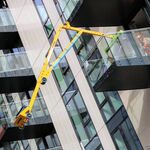Northern Light
Superstar
I have a (personal) list of priorities for new/expanded Provincial Parks in southern Ontario.
Some have plans associated w/them (formally) for their creation/expansion while others are my 'wish list' alone.
I would identify the following priorities:
Rondeau Provincial Park, major expansion: Reason, there is not a single wilderness class park in the south-west portion of the province. Rondeau is the largest park in this region, and adjacent areas are relatively low-cost to acquire, including some homes, and lots of farm.
Below is a photo of the expansion I would like to see which would allow this area to function as a wilderness park. The existing park is the dark green peninsula. The area w/the white outline is what I would add, roughly increasing the park size by a factor of 4 to 12,000 ha or 30,000 acres.

Next would be a new park to link Presqu'ille to Sandbanks.
This would relieve congestion at 2 very popular parks allow the the Bay area to be more natural for wildlife and create a critical mass of natural shoreline. Lake Ontario's shoreline is almost entirely urbanized along the western half of the Lake, and much of the rest is cottage/agriculture. It would nice to set aside a real area of nature on Lake Ontario.

Third would to assemble larger parks along the Niagara Escarpment.
Beginning with an enlarged Shorthills Provincial Park.
I would enlarge it to combine it with nearby Conservation Areas, and to provide both a continuous natural corridor to the lake, and the headwaters of at least on major creek.
This would add roughly 1,800ha to the current areas and linking 3 conservation areas and the exiting provincial park:

PS, I'm quite fond of the Pelham Winery and would be open to a carve-out, LOL
In total this would protect a ~10,000 acre area in Niagara, a bit smaller than Rouge Park.
This would likely be my most expensive new park:
I would combine the majority of Halton Region Conservation Properties.
Crawford Lake, Rattlesnake Point, Kelso and Hinton Falls along with Mt. Nemo and link all points between, plus build a wildlife corridor (vegetated bridge) across the 401.
This would be a 16,000ha, 40,000 acre park.

This would be my last super park on the Escarpment south of Owen Sound:

It would combine the existing Boyne Valley Provincial Park, Hockley Valley Nature Reserve and Mono Cliffs Provincial Park into a single park enlarged by occupying the spaces between these.
A good deal of this area is already natural.
***
I have a few more sites in mind, but I think that's enough for one day!
Some have plans associated w/them (formally) for their creation/expansion while others are my 'wish list' alone.
I would identify the following priorities:
Rondeau Provincial Park, major expansion: Reason, there is not a single wilderness class park in the south-west portion of the province. Rondeau is the largest park in this region, and adjacent areas are relatively low-cost to acquire, including some homes, and lots of farm.
Below is a photo of the expansion I would like to see which would allow this area to function as a wilderness park. The existing park is the dark green peninsula. The area w/the white outline is what I would add, roughly increasing the park size by a factor of 4 to 12,000 ha or 30,000 acres.
Next would be a new park to link Presqu'ille to Sandbanks.
This would relieve congestion at 2 very popular parks allow the the Bay area to be more natural for wildlife and create a critical mass of natural shoreline. Lake Ontario's shoreline is almost entirely urbanized along the western half of the Lake, and much of the rest is cottage/agriculture. It would nice to set aside a real area of nature on Lake Ontario.
Third would to assemble larger parks along the Niagara Escarpment.
Beginning with an enlarged Shorthills Provincial Park.
I would enlarge it to combine it with nearby Conservation Areas, and to provide both a continuous natural corridor to the lake, and the headwaters of at least on major creek.
This would add roughly 1,800ha to the current areas and linking 3 conservation areas and the exiting provincial park:
PS, I'm quite fond of the Pelham Winery and would be open to a carve-out, LOL
In total this would protect a ~10,000 acre area in Niagara, a bit smaller than Rouge Park.
This would likely be my most expensive new park:
I would combine the majority of Halton Region Conservation Properties.
Crawford Lake, Rattlesnake Point, Kelso and Hinton Falls along with Mt. Nemo and link all points between, plus build a wildlife corridor (vegetated bridge) across the 401.
This would be a 16,000ha, 40,000 acre park.
This would be my last super park on the Escarpment south of Owen Sound:
It would combine the existing Boyne Valley Provincial Park, Hockley Valley Nature Reserve and Mono Cliffs Provincial Park into a single park enlarged by occupying the spaces between these.
A good deal of this area is already natural.
***
I have a few more sites in mind, but I think that's enough for one day!




